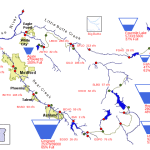March 31, 2020
EPI UPDATE The WHO COVID-19 Situation Report for March 30 reported 693,224 confirmed COVID-19 cases (58,411 new) and 33,106 deaths (3,215 new) globally. No new countries reported COVID-19 cases since the last report, but the trajectory of the growing pandemic remains largely consistent.
The Russian Ministry of Health reported a total of 2,326 cases and 17 deaths nationwide, an increase of more than 50% (803 new cases) from the previous report. On Monday, the Duma, the lower house of Russia’s Federal Assembly, reportedly passed emergency legislation intended to enable Russia to respond to its expanding COVID-19 epidemic. Multiple cities in Russia are reportedly under varying degrees of “lockdown,” including Moscow and St. Petersburg.
Iran reported 44,606 confirmed cases of COVID-19 (3,111 new), including 2,898 deaths (141 new).
The US CDC reported 140,904 cases (18,251 new) and 2,405 deaths (293 new) on March 30. The Johns Hopkins CSSE dashboard is reporting 164,610 US cases and 3,170 deaths as of 7:45am on March 31. According to the dashboard data, New York City is approaching 1,000 deaths (currently 914), and the state of New York is currently at 1,192 deaths, more than a third of the national total.
The New York Times is compiling national-level COVID-19 incidence data to track the epi curves in real time.
VULNERABLE POPULATIONS In the context of vulnerable populations during the COVID-19 pandemic, the focus has largely been on older individuals (eg, 60 years and older) and those with underlying health conditions, particularly heart and lung conditions. Yesterday, the US CDC expanded on these groups and published an overview of the available information and guidance for pregnant women and individuals experiencing homelessness. The CDC notes that the extent to which pregnant women are at increased risk for infection, disease, or severe disease remains uncertain. Other coronaviruses and respiratory viruses (e.g., influenza) can be more severe in pregnant women, but additional study is required for COVID-19. It is also unknown whether COVID-19 can cause complications for the fetus during pregnancy or if mothers can transmit the virus vertically to the fetus. The CDC recommends that pregnant women take the same precautions as the general public, including cough etiquette, hand hygiene, and social distancing. Additionally, the CDC has not yet determined whether the virus can be transmitted via breast milk, and it is unclear whether antibodies can be passed via breast milk to confer protection to infants.
Individuals experiencing homelessness can often be at elevated risk for communicable disease transmission, due in part to living in densely populated and often unsanitary conditions. Additionally, these individuals may face additional barriers to seeking care when they do become ill, which can increase the risk of severe disease or further transmission. The CDC published guidance for health departments, community service organizations, housing agencies, and health systems to mitigate the risk to individuals experiencing homelessness. While some homeless encampments can feature characteristics that could facilitate SARS-CoV-2 transmission, the CDC recommends against breaking up encampments unless individual housing is available. Breaking up encampments could “cause people to disperse throughout the community and break connections with service providers,” which could place them at even higher risk and facilitate further community transmission. Instead, local officials should ensure that encampments have access to adequate washing and restroom facilities, stocked with soap and clean water, and that proper spacing between individuals is available to reduce transmission. The CDC focuses heavily on communicating with these communities, which can be difficult. A multi-sectoral approach is critical, engaging a myriad of relevant government and non-government organizations as well as key community leaders. The CDC also recommends developing plans to house individuals who test positive for SARS-CoV-2 or are awaiting test results as well as those who are discharged from the hospital but still require isolation while they recover.
The CDC also published guidance for hemodialysis clinics to protect patients and staff. While many aspects of daily life have been upended by social distancing efforts, services like hemodialysis provide life-saving care for many individuals, and their continued operation is vital. The recommendations include rapidly identifying and isolating individuals with respiratory symptoms (including appropriate sick leave policies for staff), ensuring patients maintain 6-foot separation in waiting rooms and treatment areas, and utilizing proper PPE. The guidance also notes that patients with respiratory symptoms should be immediately moved from the waiting area to an isolation area for treatment in order to mitigate the risk of exposure to other patients.
COVID-19 LABOR STRIKES Concerns regarding protection against COVID-19, access to paid sick leave, and financial compensation have led workers at multiple large companies to strike this week. Yesterday, thousands of warehouse and delivery employees (and contractors) for Amazon and Instacart walked off the job. Additionally, some employees of Whole Foods (owned by Amazon) have planned a “sickout” (i.e., employees will call in sick) for today. These workers feel that they are at elevated risk for SARS-CoV-2 transmission due to their role in handling and delivering products in the community, and they believe that their employers are not doing enough to protect them against infection or support their health and financial security if they are infected. The employees’ demands vary, but they generally include materials and procedures to improve cleaning and hygiene (including access to hand sanitizer and disinfectant wipes), expanded paid sick leave programs, and “hazard pay” due to the increased risk of exposure. Considering the increased reliance on delivery services for food and other supplies due to increasingly restrictive social distancing policies, a strike of warehouse and delivery workers could potentially cause significant disruption to the US supply chain, particularly for vulnerable individuals who are unable to leave their homes; however, major companies have already hired more employees and contractors in an attempt to compensate for the increased demand.
HOSPITAL SHIPS On March 18, US President Donald Trump announced that the Department of Defense would deploy 2 hospital ships, the USNS Mercy and Comfort, domestically to support the COVID-19 response in California and New York. Yesterday, the Mercy began treating its first patients in Los Angeles, California, and the Comfort arrived in New York City and will have 750 beds immediately available to treat patients. The ships provide hundreds of additional beds and other medical capacity, including operating rooms, to mitigate the strain on local health systems. The ships will not treat COVID-19 patients, but reducing the number of patients at other facilities will provide additional capacity in local hospitals and other facilities to handle the COVID-19 patient surge. Unfortunately, crowds of New Yorkers reportedly ignored social distancing recommendations and mandates in order to view the ship arriving.
US AIRCRAFT CARRIER OUTBREAK An ongoing outbreak onboard the USS Theodore Roosevelt aircraft carrier could potentially put thousands of US Sailors and Marines at risk for COVID-19. Several identified cases have been evacuated from the ship, but the majority of the more than 100 cases onboard remain. The ship’s Commanding Officer, Captain Brett Crozier, reportedly issued a plea for support from the Department of Defense, including quarantine facilities for the crew. Due to the nature of living conditions and operations onboard an aircraft carrier, it is impossible to effectively quarantine or isolate Sailors and Marines. These conditions are ideal for rapid transmission, and according to the letter, the outbreak is “accelerating.” The ship is currently in port in Guam, but most of the crew remains onboard due to a lack of suitable quarantine space on the base. Disembarking the entire crew would essentially remove the ship from service. Only 11 aircraft carriers are in active service—and only a few are currently deployed—so the loss of one, even temporarily, could have significant impacts on US Navy operations.
Another outbreak at the US Marines’ training center in Parris Island, South Carolina, has reportedly resulted in at least 20 cases. The outbreak has delayed the arrival of new recruits for training, and base officials are determining the appropriate response to contain the outbreak. Prior to the outbreak, new recruits were required to be quarantined for 14 days upon arrival to reduce the risk of such outbreaks. The initial cases were reportedly identified during the recruits’ quarantine period.
Subscribe to Our Newsletter
Donate
- Ashland Council Hands Out $660,000 to Support Affordable Housing Efforts, Social Services ProgramsBy David RunkelIn Analysis, Ashland, Columns, Community, Education, Government, Jackson County, Opinion, X Council Watch, X Good NewsAshland Council Hands Out $660,000 to Support […]
- Ashland City Hall Tidbits (Update)By David RunkelIn Analysis, Ashland, Columns, Community, Education, Features, Government, Jackson County, Opinion, X Council WatchCity Hall Tidbits 4/15/24 By David Runkel $75 […]
- Advisory: Helicopter Operations Begin Thursday, April 18 in Ashland WatershedBy Chronicle ContributorJackson/Josephine County, OR Advisory: ASHLAND, OR: […]
- Vegan Diet Plan Goes Down the Disposal in AshlandBy David RunkelIn Analysis, Ashland, Columns, Community, Education, Environment, Features, Government, Health News & Care, Jackson County, OpinionVegan Diet Plan Goes Down the Disposal 4/12/24 By […]
- Hiring a Homeless Services Coordinator Tentatively Approved by Ashland City CouncilBy David RunkelIn Analysis, Ashland, Columns, Community, Education, Government, Health News & Care, Jackson County, Opinion, X Council WatchHiring a Homeless Services Coordinator Get Tentative […]
- Ashland Police Officer Could Be Stationed at Ashland High SchoolBy David RunkelIn Analysis, Ashland, Columns, Community, Education, Government, Jackson County, Law Enforcement, OpinionAshland Policeman Could Be Stationed at High School […]
 Deborah Oropallo: Moving Pictures Opens at the Schneider Museum on SOU CampusBy Chronicle ContributorDeborah Oropallo: Moving Pictures Opens by Joan Kaplan […]
Deborah Oropallo: Moving Pictures Opens at the Schneider Museum on SOU CampusBy Chronicle ContributorDeborah Oropallo: Moving Pictures Opens by Joan Kaplan […] Talent Irrigation District Reservoir Update 4/16By Chronicle ContributorIn Ashland, Business, Community, County, Drought in Oregon, Environment, Government, Jackson County, Pressing Matters, Talent and PhoenixRogue River Basin Teacup Diagram Source: Talent […]
Talent Irrigation District Reservoir Update 4/16By Chronicle ContributorIn Ashland, Business, Community, County, Drought in Oregon, Environment, Government, Jackson County, Pressing Matters, Talent and PhoenixRogue River Basin Teacup Diagram Source: Talent […]- WATER SUPPLY – IRRIGATION SEASON UPDATE – Talent Irrigation DistrictBy Chronicle ContributorIn Ashland, Business, Community, County, Drought in Oregon, Education, Environment, Government, Jackson County, Pressing Matters, Talent and PhoenixWATER SUPPLY – IRRIGATION SEASON UPDATE April 17, 2024 […]
 ‘Are nursing homes our only option?’ These New Centers Offer Older Adults an Alternative, Oregon Is Buying into ThemBy Chronicle ContributorIn Ashland, Community, County, Education, Features, Government, Health News & Care, Jackson County, X Good News‘Are nursing homes our only option?’ These centers […]
‘Are nursing homes our only option?’ These New Centers Offer Older Adults an Alternative, Oregon Is Buying into ThemBy Chronicle ContributorIn Ashland, Community, County, Education, Features, Government, Health News & Care, Jackson County, X Good News‘Are nursing homes our only option?’ These centers […]- Oregon Fringe Festival “Building Catharsis & Community through Theatre, April 24-28 at SOUBy Chronicle ContributorRussell Copley Director of the Oregon Fringe Festival […]
- Religious Service – Ashland South Mountain Friends Meeting Sundays at 11:00amBy Chronicle ContributorSouth Mountain Friends Meeting Meeting for Worship, 11 […]
- Ashland Memorial Announcement for Kate NehrbassBy Chronicle ContributorMemorial Announcement – April 20 There will be a […]
- Collaborative Theatre Project – It’s Time to Get Groovy Again Where the 18th Century Meets the 1960’s British Pop Invasion, Starts 4/25By Chronicle ContributorIt’s Time to Get Groovy Again! Henry Fielding’s […]
 New Dept. of Transportation Partnership Streamline Airline Consumer Complaints, Oregon Is InterestedBy Chronicle ContributorIn Business, Community, Education, Government, Jackson County, Josephine County, National, Pressing Matters, State, X Good NewsNew DOT partnership will streamline airline consumer […]
New Dept. of Transportation Partnership Streamline Airline Consumer Complaints, Oregon Is InterestedBy Chronicle ContributorIn Business, Community, Education, Government, Jackson County, Josephine County, National, Pressing Matters, State, X Good NewsNew DOT partnership will streamline airline consumer […] Bynum, Jayapal Lead in Fundraising in Competitive Oregon Congressional PrimariesBy Chronicle ContributorIn Community, Education, Government, Jackson County, Josephine County, National, Pressing Matters, StateBynum, Jayapal lead in fundraising in competitive […]
Bynum, Jayapal Lead in Fundraising in Competitive Oregon Congressional PrimariesBy Chronicle ContributorIn Community, Education, Government, Jackson County, Josephine County, National, Pressing Matters, StateBynum, Jayapal lead in fundraising in competitive […]- Skeletal Remains Found in Rural Jacksonville, Detectives Investigating Suspicious DeathBy Press ReleaseSKELETAL REMAINS FOUND IN RURAL JACKSONVILLE AREA, […]
- Oregon Heritage Tree to be Dedicated in BrownsvilleBy Press ReleaseOREGON HERITAGE TREE TO BE DEDICATED IN BROWNSVILLE […]
